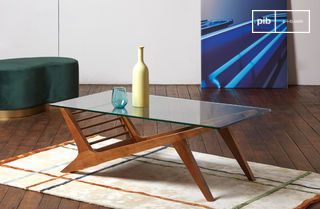Glass coffee tables
Glass coffee tables take up space without weighing it down. Their transparency allows a continuous view of the floor and volumes, making them ideal for smaller living rooms as well as more open layouts. A glass coffee table facilitates eye movement while providing a useful surface for everyday objects. Exposed wood or metal structures contribute to the overall look without blocking the light. This type of furniture finds its place in the center of a space, in direct connection with the seating, without ever imposing an excessive presence.
read more >Filters

Why integrate a glass coffee table into the living room
A glass coffee table creates a focal point without visual disruption. Its main advantage lies in its ability to let light through, avoiding any feeling of clutter. This feature is particularly useful in medium-sized living areas or in open-plan layouts where each element must contribute to spatial continuity. Glass does not obscure carpets or floor coverings, keeping the layout clear.
Used as a tray or sometimes as an integral structure, glass is tempered to guarantee everyday safety. It resists moderate impact and is easy to clean. This material is therefore compatible with regular domestic use, including in the presence of children or pets. It does not absorb liquids or odors, and retains its appearance without special treatment.
Visible structures and material layout
The transparency of the top highlights the table's lower structure. A solid wood, painted metal or stainless steel base then becomes a central element of the visual composition. Some models play on the contrasts between a smooth, clear surface and more pronounced shapes in the supports, thus introducing a discreet hierarchy into the space.
This type of table fits equally well into a minimalist decor or a more eclectic environment, as long as the surrounding furniture doesn't generate visual saturation. The main aim is to ensure that volumes are legible. Thanks to glass, even a large-format table can retain an impression of lightness. It also allows several materials to coexist without creating aesthetic conflicts.
Uses and formats adapted to everyday life
In addition to its visual qualities, the glass coffee table fulfils the functions expected in a living room. It is used to place temporary objects, organize shared moments or support decorative elements. Its size should be chosen according to the space available around the sofa and armchair, and the frequency of use. A low, wide tray is best suited to a frontal arrangement. A more compact format will suit a narrow room or modular organization.
The shape also influences circulation. A round or oval table facilitates passage through a constrained space, while a rectangular top fits more easily into an alignment of furniture. Square models reinforce the centrality of furniture in a symmetrical room. The choice therefore depends less on a decorative logic than on the relationship between the table, the seats and the surrounding access.
This furniture, often perceived as secondary, nevertheless structures uses over time. By removing the visual barrier of an opaque top, the glass coffee table integrates without blocking, connects without dominating. It meets everyday needs while maintaining the clarity of the interior layout.
